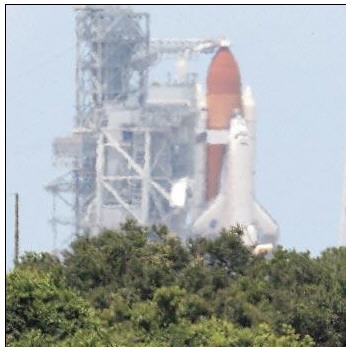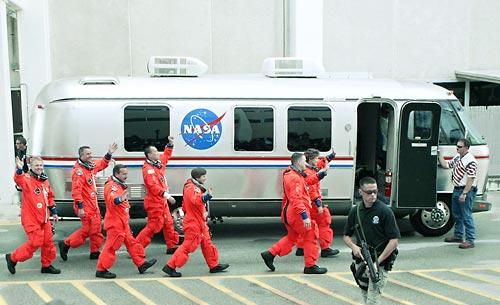|
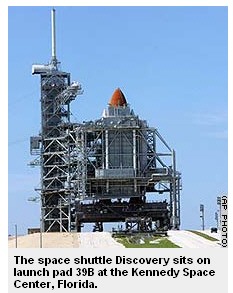
Next week earliest possible launch date
Tuesday, July 19, 2005
KENNEDY SPACE CENTER, Florida (CNN) -- Five
days of meticulous detective work by NASA engineers have failed to turn up
the cause of a fuel sensor malfunction on the space shuttle Discovery,
which is still sitting on its launch pad as precious days tick away toward
a July 31 launch deadline.
NASA officials are looking at next week as the earliest possible launch
date.
"It's difficult to find a glitch that won't stay glitched,"
said Bill Parsons, the space shuttle program manager, at a news conference
Monday evening.
To help find the malfunction, NASA has brought out of retirement an
engineer who designed part of the sensor system back in the 1970s, said
Wayne Hale, deputy shuttle program manager.
NASA officials will decide by Wednesday whether they need to fill the
shuttle's external tanks with super-cooled hydrogen and oxygen to help
isolate the problem, which would delay a launch until at least July 26, he
said.
The current launch window for Discovery ends July 31, after which the
launch might have to be postponed until at least September 9. NASA
officials are debating whether the window could be extended to August 4,
to give them more time to find and fix the sensor malfunction.
The current launch window was chosen to provide ideal lighting
conditions so that Discovery's ascent can be photographed by a new network
of cameras installed on the vehicle, which will help the space agency
evaluate design changes made after the 2003 Columbia disaster.
In the first days of August, Discovery would be in deep shadow at the
point where the external tanks separate from the orbiter. However, some
NASA officials believe digital photographs taken out of the window of the
orbiter by Discovery's crew could compensate for any dark pictures.
Discovery's mission would be the first space shuttle flight since its
sister ship, Columbia, disintegrated over Texas on February 1, 2003,
killing all seven astronauts on board.
NASA shut down the program and made numerous design changes and safety
improvements to the shuttle fleet recommended by a blue-ribbon panel that
investigated the disaster.
Last Wednesday, less than two and a half hours from liftoff,
Discovery's mission had to be scrubbed when a pre-flight test showed a
sensor in the hydrogen fuel tank was not working correctly. To test the
sensor, a command was sent that should have made it show the tank as
empty, when it was actually full. But the reading didn't change.
NASA engineers believe the problem lies somewhere along the path from
the sensor in the fuel tank to computers on the orbiter which process the
information, but they have so far been unable to isolate what they term an
"intermittent anomaly."
Tests of an electronic box in the orbiter that captures data from the
sensor were successful, and checks of the wiring in the orbiter and
external fuel tank, as well as the connections between the two, also
turned up no problems, said Ed Mango, deputy director of NASA's orbiter
project office.
So far, the testing that has been done has been conducted at normal
temperatures, rather than under temperature conditions at launch, when the
super-cooled fuel is loaded in the tanks.
The unloaded testing should be completed by Wednesday, at which point
the decision will have to be made whether to perform more tests with the
tanks loaded, known in NASA parlance as a "tanking test."
Hale said the earliest a tanking test could be performed would be next
Tuesday. Once the tanks are loaded, an immediate launch would be possible,
although Hale said a more likely scenario would be to launch the following
day.
The sensor that malfunctioned is one of four that monitor hydrogen
levels in the fuel tank. Launch protocols require that all four be working
at launch, to provide redundancy in case more than one sensor fails.
Hale said Monday that prior to the Challenger disaster in 1986, NASA's
flight rules did allow a space shuttle to fly with just three of the four
sensors working. That was changed after a post-Challenger evaluation
showed that a single malfunction could knock out two sensors because of
the way the system was designed, he said.
If the problem cannot be isolated, NASA officials could consider
allowing Discovery to fly with just three sensors working properly,
although Hale said the space agency would much prefer to find and fix the
problem.
An in-flight malfunction of the sensors could lead to two different,
but potentially catastrophic, outcomes.
If the sensors fail to indicate that fuel levels are running low, fuel
pumps could continue to operate after the fuel is exhausted, which could
cause an explosion if engines overheat or seize up. On the other hand, if
the sensors indicate fuel is running low when it isn't, on-board computers
could shut down the shuttle's main engines, which could force the craft to
make an emergency landing if it fails to achieve orbit.
To compensate for a missing sensor, NASA might have to more rigidly
time the launch so that Discovery gets to its desired orbit using a
minimum of fuel.
If NASA officials decide to proceed with the tanking test, engineers
are considering switching the wiring between the faulty sensor and one of
its working siblings, to determine whether the problem lies with the
sensor or the electronics attached to it, Parsons said.
Discovery's seven-person crew is led by retired Air Force Col. Eileen
Collins, NASA's first female shuttle commander. Over the course of the
12-day mission, the crew will test a battery of new tools and techniques
NASA engineers developed in the aftermath of Columbia to inspect the
spacecraft's heat-resistant exterior tiles for any damage that might have
occurred during liftoff.
The shuttle will also dock with the space station to deliver
much-needed equipment and supplies
The panel that investigated the Columbia disaster concluded that a
piece of insulating foam fell off the external fuel tank during liftoff
and struck the shuttle's wing, cracking the tiles. The breach caused
Columbia to disintegrate during the heat of re-entry.
CNN's Kate Tobin contributed to this report.
|
Shuttle launch time set
Discovery can lift off Tuesday even if a
sensor fails again, NASA says.
By Robyn Shelton
Sentinel Staff Writer
July 21, 2005
NASA will try again to launch shuttle Discovery on Tuesday after
engineers expressed confidence that they had pinpointed the
fuel-sensor problem that scrubbed last week's liftoff.
Blaming a minor electrical issue for delaying the shuttle's return to
flight, NASA managers said Wednesday that they can fly even if the
sensor acts up again during final preparations for launch.
If all goes well, the countdown clocks will start ticking Saturday
afternoon. Liftoff is set for 10:39 a.m. Tuesday.
"We have a great amount of work in front of us to get us through
this and get us ready for this, but we all agree that this is
doable," said Bill Parsons, shuttle-program manager.
Teams of NASA engineers have been working on the problem since managers
called off Discovery's launch July 13. They strongly suspect that the
malfunctioning sensor is being affected by an electrical-grounding
problem on the shuttle, Parsons said.
Additional tests are needed, but all the evidence is pointing in that
direction, said John Muratore, NASA manager of systems engineering and
integration at Johnson Space Center in Houston.
"This has been a very, very thorough effort," he said.
"We've used every kind of analysis and test technique we could
find" to investigate the problem.
NASA is hoping to send Discovery on its 12-day mission to the
international space station before the current launch window closes Aug.
4. If that happens, the agency would have to wait until September for
more opportunities.
Discovery's flight will be the first since seven astronauts were killed
when shuttle Columbia broke apart over Texas as it headed for a landing
in Florida on Feb. 1, 2003.
Discovery was only 21/2 hours from liftoff last week when the sensor
failed to respond to computer commands. An estimated 250,000 people had
swarmed into Brevard County to see the historic flight.
In the days since, the cause of the sensor glitch had eluded engineers.
The faulty device is one of four so-called "engine cutoff"
sensors in the bottom of the external fuel tank where liquid-hydrogen
fuel is stored.
The sensors are an emergency precaution meant to trigger the shutdown of
the spaceship's main engines if the hydrogen runs out too soon. In
normal launches, the sensors aren't needed, and the shuttle's computers
turn off the engines when the ship has picked up enough speed to reach
its planned orbit.
NASA requires all four sensors to be working properly at liftoff, but
that hasn't always been the case. Three sensors used to be sufficient in
the program's early days, but a review after the Challenger disaster in
1986 triggered the change to four.
Nonetheless, Parsons said the agency likely would accept three working
sensors during Discovery's launch if the malfunction were clearly
understood.
Parsons said NASA would stop short of officially changing the technical
rules in place for going through with a launch. But the agency would be
ready to waive the requirement for this liftoff if the same problem
emerges with the sensor.
"If we see a signature that we understand, then we'd make an
exception and fly with three [sensors]," he said.
Muratore said engineers still were working on plans to do extensive
testing of the sensors during Discovery's countdown. If anything unusual
occurred, they would call off the launch and regroup.
Once in orbit, Discovery is to dock at the international space station
so its crew can drop off supplies and carry out a series of spacewalks.
The excursions outside include work on the station itself as well as
tests of potential repair techniques in case a shuttle ever becomes
damaged again during launch.
Columbia was mortally wounded on its climb to orbit when a piece of foam
fell off its external tank and struck its left wing, creating a hole
that allowed superheated gases to get inside the ship and trigger its
destruction after it re-entered the atmosphere.
Robyn Shelton can be reachedat rshelton@orlandosentinel.comor
407-420-5487.
|
| According to the astrology chart of the Shuttle, here
is the prediction:
In viewing this chart,
there are a number of concerns.
Mercury, ruling the
chart and therefore the health and longevity of the Shuttle, is weak
in old age, and is under the wide aspect of Rahu, ruling explosions
and unexpected calamities.
Mercury is ruled by the
Moon, which is also closely afflicted by Rahu.
The operating planet,
Venus, the natural signficator for conveyances and ruling the second
house of status and continuation of family life, is badly placed in
the twelfth house of losses and expenses.
The ruler of the
twelfth house, Sun, is closely afflicted by the functional malefic
Saturn, ruling the sixth house of fire and conflicts.
(Saturn is combust and
under the aspect affliction of Mars, the eighth ruler of
delays, obstructions, accidents and deathlike experiences.)
Sun, representing
government, and ruling the twelfth house of losses, is also weak
on account of the weakness of its dispositor, the afflicted Moon.
The well placed
Jupiter, ruling the fourth house of conveyances, and Mars, placed in
its own mooltrikona sign, may be helpful, but it seems that overall
the chart is connected with losses, explosions, accidents,
obstructions, delays, etc.
Once again, I predict a
cancellation of the launch, or serious problems with the mission.
Let's pray for the
welfare of the crew and their families.
|
NASA Suspending Shuttle Program Over Foam Debris
By JOHN SCHWARTZ
Published: July 28, 2005
HOUSTON, July 27 - NASA suspended further flights of the space
shuttle fleet on Wednesday after determining that a large piece of
insulating foam had broken off the external fuel tank of the
Discovery shortly after liftoff Tuesday morning, the same problem
that doomed the Columbia and its seven astronauts in the last
mission, two and a half years ago.

NASA TV, via Reuters
A photo taken from the payload bay of the
space shuttle Discovery shows the orbiter's tail and robot
arm.
The foam does not appear to have struck the Discovery, so the
decision will not curtail its 12½-day mission to the International
Space Station, the officials said. But further flights will be
postponed indefinitely, starting with that of the Atlantis, which
was to have lifted off as early as September.
"Until we fix this, we're not ready to go fly again,"
William W. Parsons, the manager of the shuttle program, said at a
news briefing at the Johnson Space Center here on Wednesday evening.
The detection of another large breakaway piece of insulating foam
is a potentially devastating setback for the National Aeronautics
and Space Administration and a bitter counterpoint to the elation of
Monday's seemingly perfect launching of the Discovery, a return to
flight that was hailed as an inspiring comeback for the space
program.
The effort to fix the foam problem had consumed more than two
years and hundreds of millions of dollars. NASA identified the area
on the tank that shed the latest piece of foam as a risk, but put
off redesigning it.
"We decided it was safe to fly as is," Mr. Parsons
said. "Obviously, we were wrong."
The incident occurred two minutes into the launching, at a point
where the atmosphere is so thin that the piece drifted away. The
Columbia accident occurred in part because the foam fell off the
tank about 82 seconds after liftoff, when the air was much thicker
and slowed the foam so the climbing orbiter struck it with great
force.
N. Wayne Hale, the deputy manager of the shuttle program, said
that if the Discovery foam had been shed earlier, "we think
that it would have been really bad."
Tense and somber, Mr. Parsons said that he was
"disappointed" in the news. Mr. Hale sounded resigned.
"We are in the business of flying in space - it's a very
difficult business," he said, adding: "It isn't
disheartening. It's just the nature of the business."
Others were more dismayed. A NASA engineer who has been involved
in the return-to-flight effort said: "It's an ugly story. It's
a mess." The engineer, who spoke on the condition of anonymity
because of the delicacy of the issues involved, added,
"Everyone's really, really disappointed," but continued:
"It is what it is. Physics doesn't lie."
Alex Roland, a former NASA historian who now teaches at Duke and
is a frequent critic of the space program, said that in some ways
the problem was "worse than an unexpected anomaly
arising."
"This was the major problem that they were looking to
solve," Mr. Roland said. "It must be enormously
demoralizing to them."
Representative Sherwood Boehlert, a New York Republican who is
chairman of the House Science Committee, said the shuttle program
was "rightly grounded."
"Nothing can go forward at this juncture until there is
further analysis and a remedy to the problem," Mr. Boehlert
said. "It all depends on what they find. In some respects, it's
back to the drawing board."
The Columbia and its crew were lost because a 1.67-pound piece of
insulating foam that had fallen off the external tank during liftoff
crashed through the leading edge of the shuttle's left wing. The
resulting hole admitted superheated gases during the shuttle's fiery
re-entry into the atmosphere on Feb. 1, 2003.
That chunk fell from an area of hand-applied foam called the
bipod arm ramp. The ramp's insulating foam surrounded the struts
connecting the tank to the orbiter, and were originally designed to
prevent ice from forming and becoming a debris hazard. But NASA had
noticed that the bipod arm ramp tended to shed foam and decided to
redesign it. They planned to replace it after the Columbia flight.
After the Columbia accident, the investigators who implicated the
falling foam as the physical cause demanded that NASA find ways to
sharply limit the amount of foam that falls off the external tank.
Just as important, the investigative board determined, a
"broken safety culture" tended to play down risks.
In response, NASA extensively tested foam and the way it is
applied, modified the tank so that it would be less likely to shed
debris, and replaced the foam-covered ramps with a heater.
In the incident described here on Wednesday, the new piece of
foam - a hat-shaped chunk as much as 33 inches across at the widest
part and 14 inches at the narrow part - sheared off another ramp on
the external tank. It is known as the protuberance air load ramp,
which NASA abbreviates as the PAL ramp, and was designed to minimize
crosswise airflow and turbulence around cable trays and lines used
to pressurize the external tank. The new piece is slightly smaller
than the briefcase-size piece that hit the Columbia, Mr. Hale said.
With so much riding on the Discovery launching, critical
changes have been made to the shuttle. Also, a look back at
the history of the shuttle program.
Because of the other redesign efforts on the external tank, NASA
engineers estimated that no piece of foam would come off the
external tank that was larger than three-hundredths of a pound, and
said they hoped to see no foam debris larger than one-hundredth of a
pound.
On Wednesday, Mr. Parsons, who led the program requirements
control board that considered all modifications, said, "We had
enough data that showed we had had very few problems with the PAL
ramp." The ramp, they found, performed a valuable protective
function, he said; with no other obvious options, they decided the
shuttle was safe to fly.
While the two other shuttles, Atlantis and Endeavour, are
grounded, work will begin on solving the PAL ramp problem.
"We'll put our best people on it," Mr. Parsons said,
"and we'll figure out something to do."
"I don't know if that's a month, I don't know if that's
three months," he went on. "We've got a lot of work in
front of us."
But before that, the officials said, there is still a mission to
complete and seven astronauts in space. Using the official numerical
designation for the flight, Mr. Hale said, "Right now this team
is focused on STS-114, and getting this crew home safely."
That means continuing with the work that had always been intended
for the current mission: a thorough examination of the shuttle's
thermal protection system for any damage, using an array of new
cameras and laser systems.
Mr. Parsons and Mr. Hale said there were other surprising
examples of lost foam - including divots several inches long that
popped out of "acreage foam," which is applied robotically
and had been considered to be free of shedding problems.
They also showed photos of the loss of a 1.5-inch piece of an
insulating tile over a landing-gear door on the nose cone, which
they suggested might have sheared because of an earlier repair. Mr.
Hale said the tile would receive further examination, but was not
considered a critical problem now.
"Are we concerned about this? We're treating this very
seriously," he said. "Are we losing sleep over it? Not
yet."
Mission managers said they briefly discussed the news of the foam
chunk with the astronauts in the afternoon, and transmitted pictures
to Discovery in the early evening after the astronauts' bed time.
The shuttle astronauts - the commander, Col. Eileen M. Collins;
the pilot, Col. James M. Kelly; the flight engineer, Stephen K.
Robinson; and the mission specialists, Soichi Noguchi, Andrew S. W.
Thomas, Capt. Wendy B. Lawrence and Charles J. Camarda - spent most
of their workday using the shuttle's robot arm and a 50-foot
sensor-tipped boom to inspect the craft's nose and the wings'
leading edges, and preparing to dock with the International Space
Station.
During slow, close-up scans of the reinforced carbon structures
with a high-definition television camera and laser scanners, no
obvious damage was spotted. Though the preliminary results look
promising, Mr. Hale said, there are problems with viewing some areas
that will have to be repeated, and so "today we cannot tell you
without a shadow of a doubt that we've got a clean bill of
health" for those panels.
The astronauts had awakened to their first full day in space to
the song "I Got You, Babe," as excerpted from the movie
"Groundhog Day." The movie, about living the same day over
and over, was a joking reference to the seemingly endless days in
prelaunching quarantine as the crew awaited their chance to fly.
Kenneth Chang contributed reporting from New York
for this article.
|
|
Discovery Docks at Space Station
NASA Grounds Future Shuttle Flights After Foam Incident
By PAM EASTON, AP
SPACE CENTER, Houston (July 28, 2005) -
Discovery docked at the international space station Thursday after
performing an unprecedented back flip to allow those aboard the outpost
to photograph the shuttle's belly for signs of damage.
''Everything that we see at this point says
that the orbiter is in fact a clean bird,'' NASA Administrator Michael
Griffin told ABC's ''Good Morning America'' after the somersault.
Discovery was just 600 feet beneath the
station when Commander Eileen Collins manually steered the shuttle's
nose up and slowly flipped the spacecraft over.
Collins then repositioned the shuttle and
locked onto the station just after 7 a.m.
About two hours later, following leak and
pressure checks, Discovery's astronauts entered the orbital lab, where
they were greeted with hugs and bread and salt - a Russian tradition
thought to bring good luck when visiting another's home.
The station's crew then took Discovery's
astronauts on a tour.
''We're looking forward to seeing you guys,''
Collins told station Commander Sergei Krikalev when the shuttle was a
little more than 5,000 feet from the station. ''Your space station looks
absolutely beautiful from the outside.''
The astronauts' greetings inside the lab
weren't picked up by microphones.
The docking came after a huge setback
Wednesday, when NASA decided to ground future shuttle flights because a
chunk of insulating foam flew off Discovery's fuel tank during liftoff -
as it did in Columbia's doomed mission. This time, the foam apparently
missed the spacecraft.
Discovery was the first shuttle to return to
orbit in the 2 1/2 years since Columbia broke apart over Texas as it
returned to Earth on Feb. 1, 2003. All seven astronauts aboard died.
The space agency believed it had solved
problems associated with the foam on the external fuel tank, but learned
Wednesday that it was wrong. The foam prevents the formation of ice on
the fuel tank.
''We have got to go take a look at this, and
we have got to go find a solution to this problem. And we will,''
shuttle program manager Bill Parsons said.
It was the first time a shuttle hitched to the
station in almost three years. A crew last visited the outpost in
November 2002.
Discovery comes loaded with 15 tons of
much-needed supplies, including a replacement gyroscope for one that
failed in March. Gyroscopes help steer the station. The shuttle crew
planned to leave with 13 tons of trash stowed aboard the station since
shuttles were grounded.
Krikalev, a Russian cosmonaut, and astronaut
John Phillips used two digital cameras - one with a 400 millimeter lens
and another with an 800 millimeter lens - to snap 100 seconds worth of
photos of the shuttle as it flipped backward, exposing its thermal tile
belly. The photographs were expected to provide resolution similar to a
person standing within a few inches of the shuttle's tiles.
The digital photos, downloaded after docking,
are what NASA officials said they're most interested in. A team of
special analysts at NASA's Johnson Space Center in Houston plan to
examine them for any indications of damage.
In addition to the chunk of foam that broke
from Discovery's external fuel tank during launch, several smaller
pieces broke away as well. A thermal tile on Discovery's belly was also
damaged soon after liftoff.
One tile near the doors for Discovery's
landing gear - a particularly vulnerable spot - lost a 1 1/2-inch piece
that was repaired before the flight.
Deputy shuttle program manager Wayne Hale said
none of the tile damage looked serious and likely wouldn't require the
use of untested repair techniques in orbit designed after Columbia.
''We don't really have a mechanism for knowing
why a part of that tile came off,'' Hale said.
A planned inspection of Discovery's wings and
nose using a new 50-foot, laser-tipped extension to the shuttle's
robotic arm turned up nothing alarming, he said.
However, analysis will continue for the next
four to five days.
Hale and Parsons said despite attention to the
agency's decision to ground future missions, NASA's focus remains on
Discovery's mission and bringing its crew home at the end of its 12-day
mission.
''We have had some extremely great successes
within this mission,'' Parsons said.
07-28-05 09:39EDT
Copyright 2005 The Associated
Press.
|
|
Astronauts Step Out for Spacewalk to Test Repairs
By MARCIA DUNN, AP
SPACE CENTER, Houston (July 30) - Two
spacewalking astronauts armed with caulking guns, putty knives and foam
brushes practiced fixing deliberately damaged shuttle heat shields
Saturday, a job they hope they won't have to do for real.
Although Discovery suffered some scrapes and
chips during liftoff, none of the damage appears to warrant orbital
repairs, space agency officials said.
As the two astronauts completed the mission's
first spacewalk, NASA was on the verge of extending Discovery's visit at
the international space station. With future shuttle flights grounded
because of Discovery's fuel-tank foam loss during liftoff, the space
agency would like to keep the crew there an extra day to haul over
surplus supplies and chip in with some station maintenance.
In a pair of tests designed in the wake of the
2003 Columbia tragedy, astronauts Soichi Noguchi and Stephen Robinson
worked on custom-made samples of thermal tile and panels that were
cracked and gouged before flight. They squeezed and dabbed dark goo into
the crevices as they sped around the planet.
The sticky material got on their gloves and
clumped to the ends of their putty knives. But spacewalk managers had
feared a much bigger mess and were pleased with the relative neatness of
it all.
''It's about like pizza dough, like
licorice-flavored pizza dough,'' Robinson said as the near-black filler
material oozed from his high-tech caulking gun. He used a putty knife to
smooth down the substance, again and again.
''The cleaner it is, the better work you do just like anything,'' Robinson said, holding out his knife for Noguchi to wipe.
The astronauts reported some bubbling in the two repair materials - a
paintlike substance for the thermal tiles that cover most of a shuttle,
and a thick paste for the reinforced carbon panels that line the wings
and nose cap. The paste swelled up in the cracks like rising dough and,
as the experiment wore on, was harder to get to stick because of colder
than desired temperatures outside.
It was all valuable feedback; engineers wanted to
see how their creations fared in the weightlessness of space for
possible future use in an emergency. Neither the bubbling nor swelling
was surprising, said Cindy Begley, the lead spacewalk officer.
Columbia's astronauts had no such tools or
techniques at their disposal. Of course, neither they nor flight
controllers knew Columbia had a gaping hole in the left wing, left there
by a 1.67-pound chunk of fuel-tank foam insulation that broke loose at
launch.
A piece of foam just over half that size came off
Discovery's external fuel tank during last week's liftoff. It missed
Discovery, but was enough to ground all future shuttle flights. A
smaller foam fragment may have struck the right wing, but lasers and
other sensors found no evidence of damage.
None of the repair kits flying on Discovery could
mend a hole the size of the one responsible for Columbia's catastrophic
re-entry, estimated between 6 and 10 inches across. It could be years
before engineers come up with such a big patch. For now, the largest
hole that any of the repair methods aboard Discovery could tackle would
be 4 inches.
The astronauts will test a third repair
technique, essentially a plug, inside Discovery later this week.
Once the repaired samples are back on Earth,
engineers will analyze them to see how deep and how well the filler
material penetrated. None will be torched, however, to simulate the
searing heat of re-entry. The spacewalkers had to skip the one sample
intended for laboratory test-firing because they ran out of time.
In the first of three spacewalks planned for this
mission, Noguchi and Robinson also made some long-overdue space station
repairs. They restored power to a gyroscope that stopped working four
months ago and replaced a broken Global Positioning System antenna.
''Great job. Everything was just perfect. Extra
stuff got done,'' Mission Control radioed as the seven-hour spacewalk
came to a close. ''You guys get some rest.''
As soon as Robinson and Noguchi were back inside,
their shuttle crewmates pulled out their 100-foot, laser-tipped
inspection crane to survey Discovery's left wing one more time.
Engineers wanted to make sure they didn't miss any signs of damage.
On Sunday, NASA expects to wrap up all its
analysis of Discovery's thermal shielding and give the final safety
clearance for the shuttle's descent in another week.
07-30-05 16:51 EDT
Copyright 2005 The Associated Press.
| Discovery takes first step to
returning home |
August 06 2005
at 01:52PM |
|
|
Cape Canaveral, Florida - The space shuttle Discovery
separated from the International Space Station (ISS) early on
Saturday in a first step toward its journey back to Earth.
Discovery undocked at 07h24 GMT after spending eight days
attached to the space lab.
It was set to fly around the ISS at a distance of about 120m to
allow the shuttle crew to photograph the orbiting outpost and
check for any wear and tear.
The space shuttle and its crew of seven will then continue to
orbit the Earth until early Monday, when they are scheduled to
touch down at the Kennedy Space Centre on Florida's Atlantic
coast.
The space shuttle mission is the first since Columbia
disintegrated upon re-entering the Earth's atmosphere on
February 1, 2003. It will also be the last until Nasa fixes
nagging problems with the shuttle's insulation.
Foam insulation fell off Discovery upon launch, but unlike the
debris that doomed Columbia, Nasa says it did not damage the
orbiter. - Sapa-AFP
|
|
|
Discovery due to land in Florida Monday
(Agencies)
Updated: 2005-08-07 08:47
Discovery is clear to land on Monday following an "astoundingly
successful" mission, NASA said as the space shuttle initiated its
return journey after undocking from the orbiting space lab.
But managers of the National Aeronautics and Space Administration
admitted Saturday they would not rest easy until the safe landing of the
first space shuttle flight since the 2003 Columbia disaster.
During the night, Discovery's crew bid farewell to their two hosts on
the International Space Station (ISS), exchanging hugs and handshakes
with the Russian and US residents of the orbiting outpost.
"These are memories we'll have forever," Discovery
Commander Eileen Collins said before the shuttle undocked from the ISS.
Pilot James Kelly flew the shuttle around the station to check it for
any wear and tear, and then steered it away in what NASA described as
"the first step on the road home to the Kennedy Space Center."
"The undocking and the flyaround went right by the book,"
Discovery's lead flight director, Paul Hill, said Saturday at a mission
control news conference in Houston, Texas.
The crew was given the green light for its return after NASA decided
that damage on the orbiter's thermal blanket should not compromise the
shuttle's safety as it re-enters the atmosphere.
"We are good for landing," Wayne Hale, deputy manager for
the space shuttle program, said Saturday.
"This vehicle is in extremely clean shape," he added.
Discovery is scheduled to touch down Monday at 4:46 am (0846 GMT) at
the Kennedy Space Center but could try again the next day in the event
of bad weather, or head to an alternate landing strip in California or
New Mexico.
Forecasters were upbeat about conditions at the seashore landing
strip but pointed out that weather is unpredictable in Florida at this
time of year.
Hale said the landing would mark the conclusion of "an
outstandingly successful mission."
But once it is back, Discovery will be grounded with the rest of the
fleet until nagging problems with the shuttle's thermal insulation have
been fixed, though NASA managers still hope to launch another flight on
September 22.
Foam insulation fell off the shuttle's external fuel tank as the
craft blasted into orbit on July 26.
The same problem doomed Columbia, as the debris hit the orbiter's
left wing, causing a crack that eventually allowed superheated gases to
penetrate the structure upon re-entry into the atmosphere.
A key goal of Discovery's 13-day mission was to test improvements
made to the shuttle since Columbia burst into flames on February 1,
2003, killing all seven astronauts.
Discovery's crew members were "in very good spirits," said
Hale, as the seven astronauts were given time to rest before they make
final preparations for the nerve-racking moment when they re-enter the
atmosphere.
"De-orbit is not a risk-free activity," said Hill. "We
will be pretty darned happy to get to wheelstop and see this good crew
step off Discovery."
The mission initially had been scheduled to last 12 days, but an
extra day was added on so the crew could transfer as much material and
provisions as possible to the space station, amid uncertainty over the
date of the next shuttle flight.
The crew also retrieved waste and equipment to clear out space in the
cramped orbiting lab.
During the mission, Japanese astronaut Soichi Noguchi and his US
counterpart Stephen Robinson conducted three spacewalks.
On Wednesday, Robinson became the first astronaut ever to carry out a
spacewalk beneath the shuttle during orbit, to extract two protruding
pieces of fiber that risked overheating during the shuttle's re-entry.
In the other two spacewalks, Noguchi and Robinson tested repair
techniques adopted after the Columbia tragedy and replaced one of the
space station's four gyroscopes.
|
| Discovery Lands Safely in California
By ALICIA CHANG, Associated Press Writer 26
minutes ago
EDWARDS AIR FORCE BASE, Calif. - Discovery and its crew of seven
glided safely back to Earth on Tuesday, ending a riveting, at times
agonizing, 14-day test of space shuttle safety that was shadowed by the
ghosts of Columbia.
Discovery swooped through the darkness of the Mojave Desert and
landed on the Edwards runway at 5:11 a.m. PDT, well before sunrise. It
marked the conclusion of the first shuttle re-entry since Columbia's
tragic return.
The detour to California came after thunderstorms in Cape
Canaveral, Fla., prevented the shuttle from returning to its home
base.
"Congratulations on a truly spectacular test flight,"
Mission Control said once Discovery came to a stop. "Welcome
home, friends."
"We're happy to be back and we congratulate the whole team
for a job well done," Commander Eileen Collins replied.
The inherently dangerous ride down through the atmosphere —
more anxiety-ridden than normal because of what happened to Columbia 2
1/2 years ago — appeared to go smoothly. No problems were
immediately reported by Mission Control.
Held up a day by bad weather in Florida, the shuttle soared
across the Pacific and over Southern California, passing just north of
Los Angeles on its way to Edwards.
NASA adjusted the flight path in order to skirt Los Angeles because of new
public safety considerations in the wake of the Columbia disaster,
which rained debris onto Texas and Louisiana.
Discovery's journey, which began with a liftoff on July 26,
spanned 219 orbits of Earth and 5.8 million miles.
The switch to the opposite coast was a big disappointment for
the astronauts' families, who had been waiting to greet their loved
ones in Cape Canaveral. Their reunion was put on hold until Wednesday,
when they all planned to meet in Houston.
NASA's top officials also had gathered at Cape Canaveral to
welcome the crew home.
"There's nothing more that I would love to see than it here
so everybody here could be a part of this. But it's not going to
be," said shuttle program manager Bill Parsons. "I want it
to be safe, wherever the safest place is to go."
NASA called it a test flight and it was — in an alarming way
no one anticipated. A potentially deadly 1-pound chunk of foam
insulation came off the redesigned fuel tank during liftoff, missing
Discovery but demonstrating that the space agency had not resolved the
very problem that doomed Columbia.
The foam loss prompted NASA to ground future shuttle flights.
Shuttle managers freely acknowledged the mistake, while
stressing that the inspection, photography and other shuttle
data-gathering systems put in place for this flight worked exceedingly
well. What's more, no severe damage was detected on Discovery while it
was in orbit.
A torn thermal blanket under a cockpit window was left as is,
after engineers decided it posed little risk as re-entry shrapnel.
Two pieces of filler material dangling from Discovery's belly,
however, were removed by a spacewalking astronaut last week, for fear
they could lead to a repeat of the Columbia tragedy. The fabric strips
slipped out of the narrow gaps between thermal tiles for reasons
unknown.
NASA officials said a space shuttle will not fly again until the
foam problem is solved and engineers understand why the two so-called
gap fillers came loose.
Until the spacewalk to pull out the two protruding gap fillers,
astronauts had never ventured beneath an orbiting shuttle or made
repairs to its fragile thermal shielding.
"It's going to be a new beginning for the space shuttle
program," NASA's spaceflight chief, Bill Readdy, said from the
Cape Canaveral landing strip. "The approach that we've taken has
to do with a very methodical series of flight tests. It's exactly the
right approach.
"This was certainly the most documented flight in shuttle
history," Readdy added.
The shuttle astronauts spent nine days at the international
space station, restoring full steering capability to the orbiting
outpost, delivering much-needed supplies and replacement parts, and
hauling away a 2 1/2-year backlog of trash.
They successfully conducted three spacewalks, including one to
test new tools and methods for fixing a damaged shuttle heat shield in
orbit. They also pulled off some fancy new flying maneuvers, flipping
Discovery end over end near the space station so its two residents
could zoom in with cameras as part of the exhaustive search for
shuttle damage.
Flight director LeRoy Cain said over the weekend that not only
did NASA learn a lot about the shuttle with this mission, but
"we've learned a lot about ourselves."
Following the Feb. 1, 2003, Columbia catastrophe, NASA revamped
the way it managed a shuttle mission. The mission management team met
daily while Discovery was in orbit, taking time to listen to
dissenting opinions and encouraging them as well, according to its
chairman, deputy shuttle program manager Wayne Hale. Every potential
serious problem was analyzed by a team of engineers and, in the case
of the ripped blanket, even prompted a series of wind tunnel tests.
Some accused the space agency of going too far to reach a group
consensus and having "analysis paralysis." Shuttle officials
denied that was so and said their intent was to put the astronauts'
safety first no matter what, an assessment shared by Discovery's
co-pilot, James Kelly.
"Just the fact that we're here means we don't have
paralysis by analysis," Kelly said from orbit Sunday. "The
folks on the ground have done an absolutely great job trying to take
care of everything they possibly can."
___
On the Net:
NASA: http://www.nasa.gov/returntoflight/main/index.htm
| Space shuttle Discovery heads back to
Florida
|
|
|
| Saturday, 20 August , 2005,
08:03 |
|
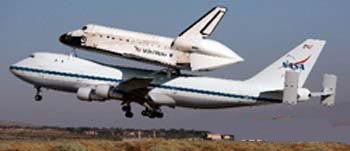
|
|
Edwards Air Force Base, California: Space Shuttle Discovery
rode piggyback atop a jumbo jet headed for Florida Friday, more
than a week after being diverted to the Mojave Desert for the
first landing shuttle since the Columbia tragedy.
| Editor's
Choice |
 |
Images: Discovery, yet another
leap for mankind |
 |
Discovery repaired in historic
spacewalk |
|
 |
The modified Boeing 747 carrying Discovery took off Friday
morning and arrived in Oklahoma about three hours later -- the
first leg of a 2,232-mile trip to the shuttle's home at Cape
Canaveral. An Air Force KC-135 flew ahead of the shuttle to
monitor weather along the route.
The plane refueled, flew to Barksdale Air Force Base in
Louisiana and is scheduled to fly to Florida Saturday. The
expected cost of the trip: at least $1 million.
Discovery and its seven-member crew touched down August 9 at
NASA's backup landing site at Edwards Air Force Base following a
14-day mission to the international space station. NASA diverted
the landing to California after low clouds and lightning prevented
the shuttle from returning to Florida during four earlier
opportunities.
After landing, Discovery underwent maintenance inside a
steel structure on the base two hours north of Los Angeles. Crews
purged the shuttle of hazardous substances, removed fuel from the
on-board tanks and attached a 10,000-pound aluminum tail cone to
eliminate drag during flight.
Discovery's homecoming has been tempered by uncertainties
about the shuttle program's future. The same foam problems that
doomed Columbia 2 1/2 years ago showed up during Discovery's
liftoff, prompting NASA to ground all shuttle flights until 2006
so engineers could find a solution.
A chunk of foam insulation broke off Discovery's redesigned
external fuel tank during liftoff on July 26, but unlike in
Columbia's case, the foam missed hitting Discovery. Columbia
disintegrated over Texas, killing all seven astronauts on board.
NASA ground crews who inspected Discovery after its return
from orbit found little damage to its exterior. Associated
|
|
THE FOLLOWING SAVED
SO IT DOESN'T GET LOST ON THE
INTERNET
STS-114
The Dark Object
|
|
STS-114
lifted off from Launch
Pad 39B, Kennedy
Space Center, on 26 July 2005 at 14:39 GMT. The
Crew has experienced some facets of Shuttle flight that are
entirely new. On orbit inspection of the heat shield, manual
repairs to that heat shield, and experiments with different
methods of on orbit heat shield repair. In addition, Discovery
carried over 15 tons of equipment and supplies to the International
Space Station, where she was greeted upon arrival by the Expedition
11 Crew. Three EVAs (Extra-Vehicular Activity or spacewalk)
were carried out. These involved Space Station repairs,
improvements, and attending to heat shield problems. A fourth
EVA to repair a flaw in the insulation below Commander
Eileen Collins window was cancelled as unnecessary. Space
Shuttle Discovery and her crew landed at Edwards
Air Force Base (NASA's
Dryden Research Center) in the California desert at 12:11
GMT on 9 August 2005. Total flight duration was 13 days 21 hours
32 minutes. The mission was highly successful, accomplishing
every goal set for it.
The
sad news is that in the wake of continued problems with external
tank insulation breaking away during liftoff, the Shuttle fleet
has been indefinately grounded until the problem is solved.
In
the morning of 28 July 2005, Shuttle Discovery was making her
final approach to rendezvous and docking with ISSy. A number of
unusual objects appeared during this operation, but the most
amazing was a dark object with a single visible light on it. At
approximately 4:43 AM CDT (9:43 GMT), as the Shuttle was at
about 2 miles (3.2 km) out from the station, this dark object
passed BETWEEN the two spacecraft. As it crossed their
paths, it momentarily blocked out part of the lights from
Discovery. Before, and after, it obscured the Shuttle lights, a
small light was seen approaching and leaving.
A
selection of animated GIFs, and a still frame, have been
prepared for your inspection. Let's look at them now, shall we?
|
|
|
GIF © 2005 Jeff
Challender
The
animated GIF above is the normal view captured from the
original VHS tape recorded "live"
at the time. In the interest of brevity, some of the frames
showing the object passing in front of Discovery have been
omitted from this GIF. They have been left in those animations
to come. The mpeg segment has also been brightened a few
points to allow a better look at the tiny light which
accompanies the dark object as it passes in front of
Discovery. Shuttle Discovery is the object which is lighted up
like a Christmas tree. Watch as the light closes in, then
something blocks out part of the Shuttle, and the light
departs toward top screen.
|
|
|
GIF © 2005 Jeff
Challender
Here
we are looking at a 250% zoom on the image of Discovery. The
approaching light is circled in yellow.
|
|
|
GIF © 2005 Jeff
Challender
From
the same 250% zoom, we have captured the light moving upward
after the dark object passed across Discovery.
|
|
|
GIF © 2005 Jeff
Challender
This
full motion animated GIF (Digitally zoomed 250%) of the
incident shows in the most detail attainable with my
equipment. The black object can even be seen to have a shape.
|
|
|
GIF © 2005 Jeff
Challender
The
same 250% zoom animation, embossed. This technique makes the
small light easier to follow.
|
|
|
© 2005 Jeff
Challender
This
frame is from approximately one hour before the dark object
manifested itself. On the hunch that the dark mass MIGHT have
been some piece of hardware attached to ISSy, I checked back
before night set in to see if anything was in the field of
view. As you can see for yourself, the scene was empty of all
save Discovery.
WHAT
was that black anomaly? I have no idea what it was. There
certainly shouldn't have been anything larger than an ice chip
in the vicinity. NASA keeps very close tabs on satellites
orbiting Earth. The chance that a satellite would pass between
the Space Station and Shuttle during such a critical maneuver
without notice is just about zero. That any such satellite
could move so SLOWLY between the two craft would
prove that it was on the SAME orbit. This reduces the
chances of a satellite to absolute zero. There IS NO
satellite orbiting parallel to ISSy.
The
only conclusion left for this writer is that the object was an
unknown. The very fact that it was dark is probably the only
reason it slipped past the ever vigilant censors at NASA.
At
all times during this incident, the camera was under the
control of the INCO in Houston Mission Control.
(INCO
- INstrument &
Communication
Officer - The man
in Houston
Mission Control Center who is responsible for operating
the Shuttle payload
bay, and robotic
arm, cameras. He also remotely operates the helmet cameras
in space suits. In
the case of ISS, this officer is referred to as the CATO
- Communications And
Tracking Officer.
In
both cases, these persons CONTROL
everything which is PERMITTED
to go out on broadcast to the public.
It is a commonly believed falacy that the cameras are operated
by Astronauts & Cosmonauts on the Shuttles, and Space
Station. Very little camera work is done by the crews. They're
way too busy for that.)
At
the end of the day, it's up to YOU
to draw your own conclusions.
©
2005 Jeff Challender
|
| |
|
During
the night of 27/28 July 2005, just a day and a half after
liftoff, Discovery was maneuvering for a rendezvous and docking
with ISSy. To accomplish this, the OMS
(Orbital Maneuvering
System) is used to make the
necessary adjustments in order to bring the Shuttle into the
exact same orbit and speed as the space station. The timing, and
length of these rocket firings must be correct to the last
decimal for the two spacecraft to come together as they do. This
page hopes to demonstrate what these rocket firings, and their
resulting debris clouds, look like. It's not often that we
actually get to see this part of the docking operations. But in
the case of STS-114, the use of the OMS was shown. And as an
added treat, it was broadcast in color as well.
So,
perhaps it's time for us to have a look at this critical portion
of a Shuttle flight to the space station.
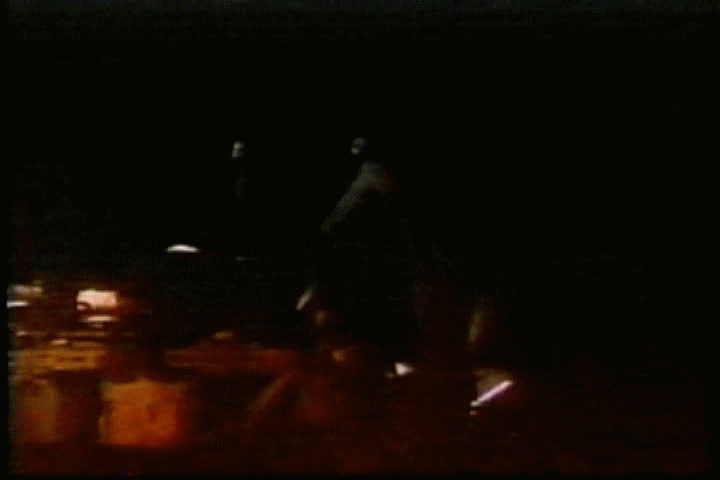
GIF © 2005 Jeff
Challender
As
you can see for yourself, the rocket firings are not only
colorful, but light up the sky as well. One thing to note from
this sequence too, is that there is none of the usual "snow"
or color distortion associated with the night use of Shuttles'
color CCTV cameras. Most of the time when we are shown
night scenes from the color cameras, the picture is terrible.
One has to wonder why this would be so. The scene above proves
that the color cameras are quite capable of rendering near
perfect video at night after all. At least, that is when NASA WANTS
us to see near perfect video. When pointing their cameras into
deep space at night, we get a much poorer quality broadcast.
This is during those times when there is the chance of
anomalous activity turning up.
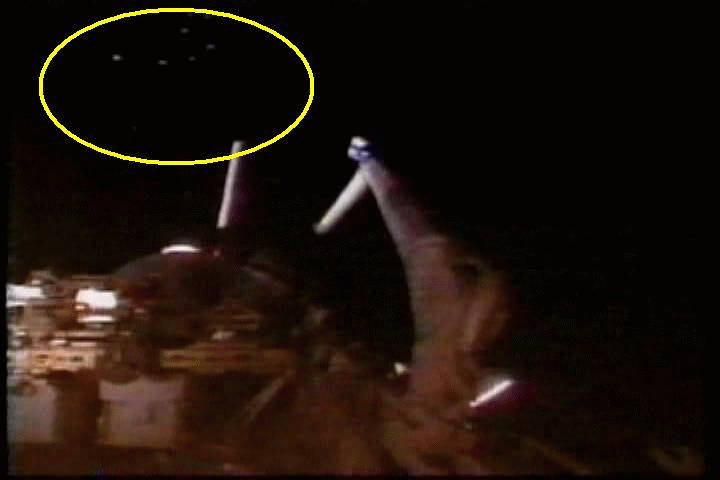
GIF © 2005 Jeff
Challender
In
the next animation, please direct your attention to the area
circled in yellow.
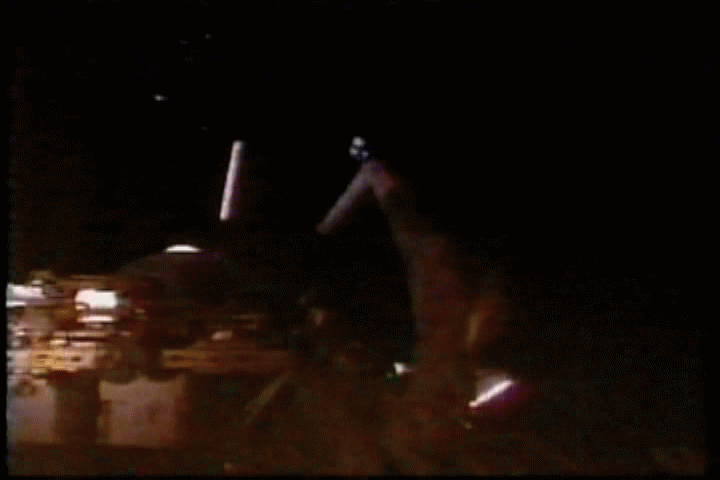
GIF © 2005 Jeff
Challender
When
Shuttles reach orbit, there is often seen lots of ice peeling
off the main engine bells at the rear of the vehicle. This ice
forms during the time of ascent to space, when super-cooled
cryogenic fuels are pumped through pipes attached in a grid
pattern all around these engine bells. This prevents the metal
the engines are made of from melting in the fierce heat of the
rocket exhaust. Using the ultra-cold fuels in this manner also
warms them up, changing them from liquid to a gaseous state
for more efficient combustion. In addition, there is
particulate matter formed from the burning of chemical fuels
in the OMS engines. These particles spew out into space when
the OMS engines are fired.
In
this animation, we can see the "cloud" of resulting
junk rising and spreading out. When the OMS engines are fired,
they frequently also shake ice chips loose from the main
engine bells as well. It can make for a pretty display, and
fool the uninformed into thinking they see U.F.O.s in the
vicinity. So we have provided this page for your comparison to
those objects we believe actually are unidentified.
At
all times during this incident, the camera was under the
control of the INCO in Houston Mission Control.
(INCO
-
INstrument & Communication Officer - The man in Houston
Mission Control Center who is responsible for operating
the Shuttle payload
bay, and robotic
arm, cameras. He also remotely operates the helmet cameras
in space suits. In the case of ISS, this officer is referred
to as the CATO
- Communications And Tracking Officer. In
both cases, these persons CONTROL everything which is
PERMITTED to go out on broadcast to the public. It is
a commonly believed falacy that the cameras are operated by
Astronauts & Cosmonauts on the Shuttles, and Space
Station. Very little camera work is done by the crews. They're
way too busy for that.)
At
the end of the day, it's up to YOU to draw your own
conclusions.
©
2005 Jeff Challender
A "Wolf"
Among The "Sheep"?
OR
A VERY Surprised INCO!
In
my e-mail inbox on the morning (PDT)
of Saturday 6 August 2005, were two letters which proved
important. One from a fellow in Europe, who identified himself
only as "Flint", and another from my friend Oren
Swearingen of Texas. These letters both referred to what the two
men had seen on their television screens simultaneously at 13:54
GMT, 6 August 2005. They had been watching NASA
Select TV, witnessed, and were Co-Discoverers
of, something that shook them both. It inspired them to request
that I review my VHS tape for the time in question. Both were
anxious to know what I might find.
Undocking
of Discovery from the Space Station had occured some six and a
half hours earlier, and the two spacecraft were separated by
many miles by this time.
What
had gotten the attention of the observers was an eerie scene
from the black & white low light camera in the payload bay
of Space Shuttle Discovery. She was, at the time, traveling
across the Pacific Ocean between Hawaii and California in a
northwesterly direction. The camera was pointing to the
southwest, and to the east the Sun had just risen for the
Orbiter. The view resembled a night scene over inhabited
countryside, with many lights, small and large, which looked
very much like cities and towns as seen during a night pass.
Most of these were seen against the dark face of the ocean, and APPEARED
to be stationary with many of them flashing.
This
field of objects was anything BUT stationary, however. At
real-time playback speed on the VCR, they certainly appeared
that way. When looked at on the computer at vastly increased
speed, the field of objects revealed itself to be a cloud of
Shuttle debris, with everything in motion. How such a large
cloud of highly reflective debris originated is a bit of a
mystery. Shuttle was flying "sideways" at the time.
The OMS
(Orbital Maneuvering
System)
engines had been used earlier to increase the distance between
Discovery and ISSy. Yet, it seems unlikely that such a thick
cloud so nearby, would STILL be extant after more than six
hours.The RCS
(Reaction
Control
System)
jets are often cited as culprits in causing unusual looking
behavior in ice flakes and debris, and as a source of ice chips
on orbit...but this much?
Now,
ignoring the cloud of debris for the time being, we are mainly
concerned here with an object which simply put, DOES
NOT BELONG! The entire "live"
downlink segment lasts 3 minutes 19 seconds from onset to the
INCO cutting it off quite suddenly to a pure black screen. (The
segment is
3 minutes 41 seconds from "map to map") At the
2 minute 10 second point, a "Wolf"
enters the flock of "Sheep".
THIS is the object which might possibly be an U.F.O. Seen at
normal playback speed on the VCR, this one appears to cross the
field of view from right to left, come to a complete stop, and
reverse itself, moving back to the right again.
"Flint"
asked if it might be a comet, and in "the same breath"
pointed out that comets do not stop and back up. This is true.
In fact, comets are very slow moving in their naked eye course
across the sky. They take days, weeks, even months to traverse
the heavens.
Meteors
are ONLY visible when they enter the atmosphere at their
horrific speeds of 40,000 to 120,000 mph (64,000
to 192,000 kph), and proceed to burn up from the heat of
friction. Other astronomical bodies appear more or less
stationary in the sky for Earth based observers, with apparent
motion due to the rotation of Earth. On orbit, this motion is
merely exaggerated by the velocity of the spacecraft, but
relatively the same.
So,
this object displayed anomalous motion. It's not natural, and it
doesn't look to be ice or debris. Dr. Swearingen also
emphasized that this object crossed his screen, stopped and
reversed.
Once
the video segment was isolated, and captured into my computer,
it could, with my video editing program (Ulead
Video Studio 9), be speeded up or slowed down as desired.
This is where the "stationary" lights were revealed to
be an ice or debris cloud in the vicinity of Discovery. And the
fact that it WAS a cloud of debris is most likely WHY
the INCO allowed the downlink to run on. He
ALLOWED the public to see this display because
he KNEW what it was.
Perhaps he even thought he was playing a cruel "UFO
Hoax" on the uninformed. When the anomalous object became
obvious, he unceremoniously cut the feed to a black screen.
But,
DID this strange object
stop, and reverse itself? The anomaly, when vastly speeded up in
its trajectory, can be seen to not stop, but swing to the right
in a long gentle turn.
So,
all that said, let's now take a few moments to scrutinize the
pictures and animations (using
Ulead GIF Animator 5) from the event, so that we may better
understand what happened, and what did not.
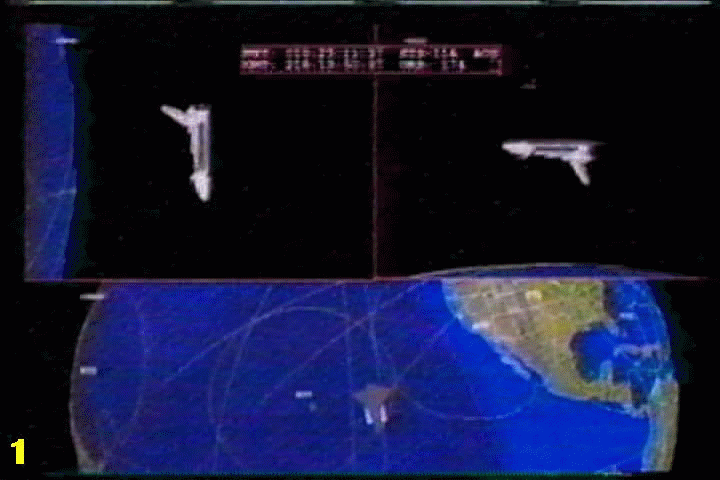
GIF © 2005 Jeff
Challender
We
begin by establishing where Discovery was at the beginning,
and end of this event. As can be seen, she was sailing along
above the western Pacific Ocean heading for a pass over
California. The yellow circle
denotes my home in the Sacramento area.
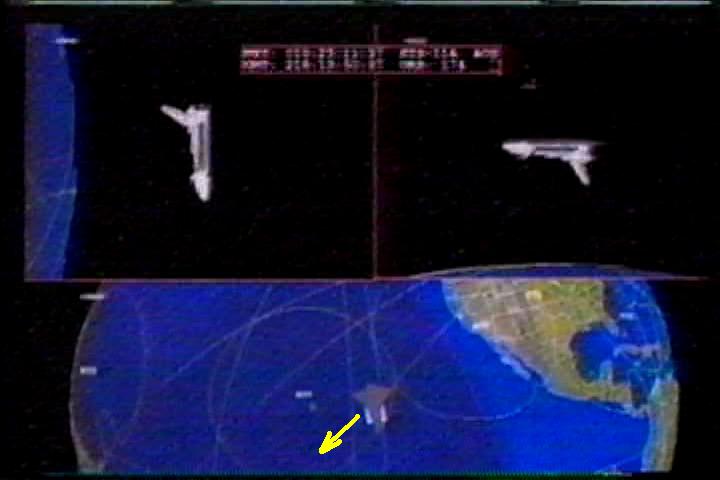
© 2005 Jeff
Challender
This
single still frame has a yellow arrow
added to show the direction in which the camera was pointing
during the incident.
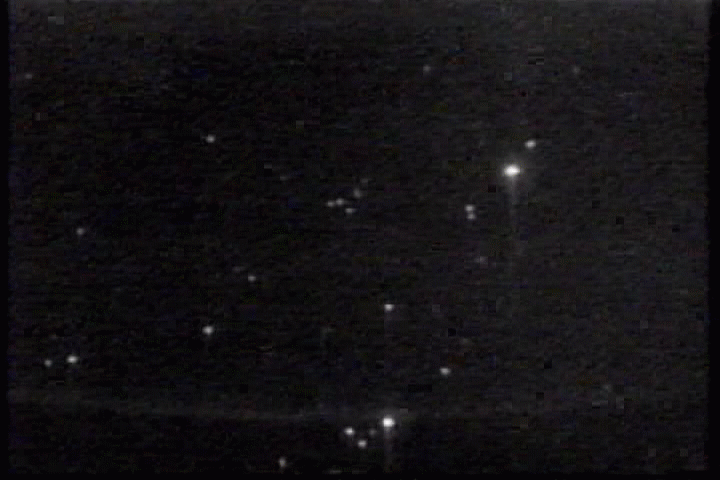
GIF © 2005 Jeff
Challender
In
this wee animation, the crude yellow line shows where the
limb of Earth is. Until almost the end of the sequence, this
perspective did not change, meaning the camera was not
moved. Near the end, and cut to black screen, the camera was
suddenly panned down and to the left.
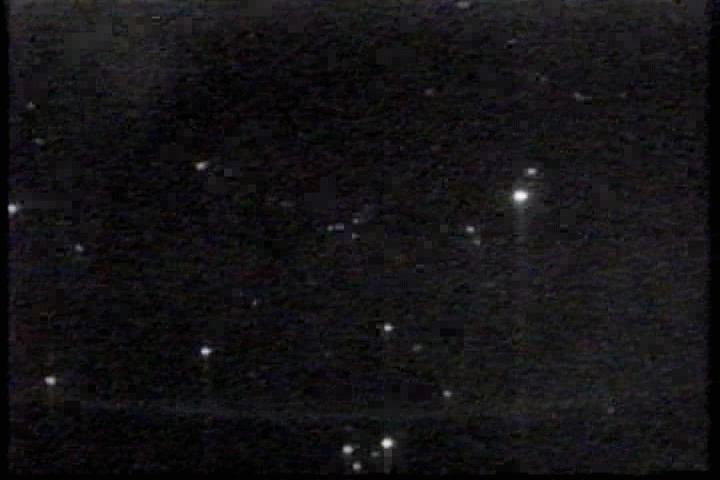
GIF © 2005 Jeff
Challender
This
animated GIF comptesses 2 minutes, 25 seconds to less than
three seconds time. It covers the period before the anomaly
entered from the right. NOW we can see that the
"lights" are not stationary, but drifting in
space, as ice chips and debris are wont to do.
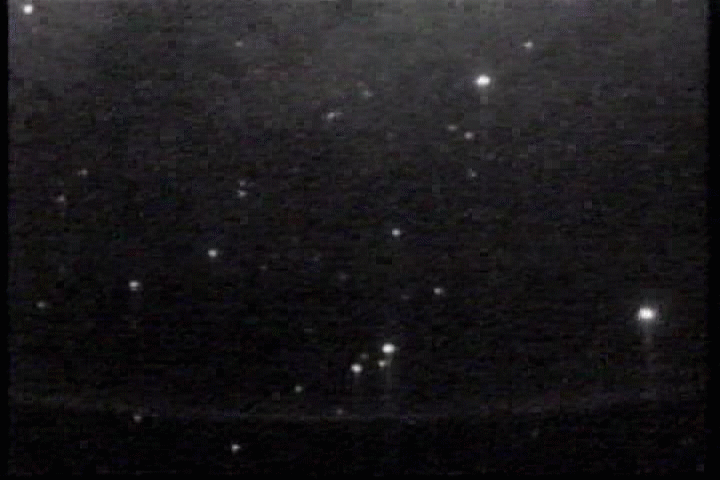
GIF © 2005 Jeff
Challender
This
41 frame animated GIF is centered on the final 55 seconds of
the sequence containing the anomaly. In the original VHS
tape, played at normal speed, this object seemed to come to
a stop, and reverse itself. But here we can see that it flew
though the field of view, and made a long curving swing to
the right. As the Sun rose higher toward the end, the clouds
over the ocean far below were illuminated. In the final
frames, the arcs of milky light which moved as the camera
moved, were caused by the Sun lighting up the optics in the
camera.
What
is it? That cannot be determined at this time.
Is
it another bit of ice or space junk being turned from it's
path by an RCS jet firing? Unknown for certain at this time.
We don't know distance from the camera for this object,
because in space there is no frame of reference for
estimating such things. Therefore, it's impossible to tell
the size of the anomaly. We CAN
see that it appears to get smaller as it progresses.
It does seem reasonable, to speculate that it's a bit far
off to be diverted so smoothly
by a control jet. In addition we do not see the
corresponding flash of light associated with these firings
at night. These flashes are often seen even in daylight as
well. Another salient point is that IF there were a jet
firing, WHY is it that
NONE of the other
objects are affected?
What
remains is that we have an unexplained object whose motion
does not fit convention. Our friends Dr.
Oren Swearingen of Texas, and "Flint"
of Europe, deserve full credit for having their eyes open,
and brains engaged when this sequence of events transpired.
Thank you very much gentlemen!
Enhancements
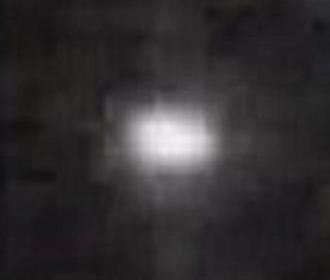
© 2005 Jeff
Challender |
The
image to the left is a 500% enlargement of the
anomalous object. It was then cut from the original
720x480 frame. |
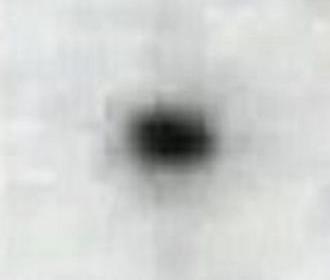
© 2005 Jeff
Challender |
This
is the same enlargements as seen above, but with the
colors reversed to make the object easier to see. |
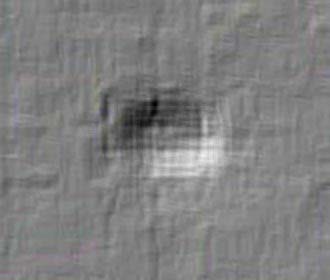
© 2005 Jeff
Challender |
The
same 500% blow-up embossed |
At
all times during this incident, the camera was under the
control of the INCO in Houston Mission Control.
(INCO
- INstrument
& Communication Officer - The man in Houston
Mission Control Center who is responsible for operating
the Shuttle payload
bay, and robotic
arm, cameras. He also remotely operates the helmet
cameras in space suits. In the case of ISS, this officer is
referred to as the CATO
- Communications And Tracking Officer. In
both cases, these persons CONTROL everything which
is PERMITTED to go out on broadcast to the public.
It is a commonly believed falacy that the cameras are
operated by Astronauts & Cosmonauts on the Shuttles, and
Space Station. Very little camera work is done by the crews.
They're way too busy for that.)
At
the end of the day, it's up to YOU to draw your own
conclusions.
©
2005 Jeff Challender
LINK
TO JEFF CHALLENDER MAIN PAGE
|
|
14/0Jeff
Challender
8/2005
|
|
|
Jeff
Challender
14/08/2005
|
|
|
Jeff
Challender
14/08/2005
|
|
|
Jeff
Challender
03/08/2005
|
|
|
Jeff
Challender
05/08/2005
|
|
|
Jeff
Challender
07/08/2005
|
|
STS-114
An U.F.O. Buzzing Discovery? 08/05 |
|
Dr.
Swearingen, Flint, & Jeff Challender
10/08/2005
|
|
|
| |
|
| |
| |
| |
| THE
COMET TEMPLE 1
STS
-107 SHUTTLE TRAGEDY OF FEBRUARY 1, 2003 AND DREAM PROPHECY
The lightning bolt hit the shuttle
2 seconds before it started breaking up. ... Space shuttle
Columbia apparently disintegrated in flames over Texas on ...
www.greatdreams.com/shuttle-STS107.htm
|
RAMS
on 19.5 & 33
19.5 is the displacement angel of
the top cone sheet of the shuttle's OMS ... 33 mph
is the speed of the shuttle after it has risen 19.5 feet
off the launch ...
www.greatdreams.com/19n33.htm - |
NOVEMBER
SPACE EVENTS
NOTE: With the shuttle
tragedy of February 1, 2003, my heart is breaking that ...
Two weeks later the 'Unity' node will be launched by the space shuttle.
...
www.greatdreams.com/nov-events.htm
|
UFO
PROPULSION SYSTEMS
Tether as it Breaks away from the
Space Shuttle ... Even NASA's black and white
video cameras on the shuttle can see into the near
ultraviolet spectrum. ...
www.greatdreams.com/ufos/propulsion.htm |
ET
EARTH BASE; SECRET SPACE STATION
Whilst the fact that a 2 man shuttle
could well have been built (The Russians were ... In fact
, I may have the only evidence that the shuttle had a
close ...
www.greatdreams.com/etsecret.htm - |
TERRORISM
- WORLD TRADE CENTER - 9-11-2001 - MILITARY PAGE
Navy Offers Shuttle Service.
With access to area Navy bases restricted and ... Shuttle
bus service will be available from the Qualcomm Stadium parking
lot ...
www.greatdreams.com/trade_military.htm |
Landing
on the Planet Mercury
For automatic e-mail subscriptions
to Shuttle status reports or KSC originated press
releases, send an Internet electronic mail message to: ...
www.greatdreams.com/mercury-landing.htm |
COLUMBIA
SHUTTLE NEWS - 2003
STS-107. SHUTTLE NEWS.
updated 6-1-04. ...
www.greatdreams.com/shuttle-news.htm
- |
DREAMING
OF ASTRONAUTS AND THE REALITY
Still, the seven shuttle
astronauts will have to wear ear plugs while working ...
(May 19, 2000) - Space shuttle Atlantis and seven
astronauts blasted into ...
www.greatdreams.com/astronts.htm - |
Galileo
Mission May End in a Blaze of Glory
PROJECT GALILEO SHUTTLE TO
CARRY LETHAL PLUTONIUM Despite scientific warnings ...
The Galileo was taken up on a shuttle in October 1989 and
sent from it on ...
www.greatdreams.com/galileo.htm |
WEATHER
ANOMALIES
Station after weather scrubbed three
launch attempts earlier in the week. ... 2 carrying the GOES-L
weather satellite to allow another shuttle launch ... ...
www.greatdreams.com/weather/weather_anomalies.htm
- |
HYDROGEN
Fuel cells electrify the space shuttle
and were used successfully in the Apollo program. Margaret K.
Mann of the National Renewable Energy Laboratory, ...
www.greatdreams.com/hydrogen.htm - |
DEES
DREAMS AND VISIONS - OCTOBER, 2001
He decides he'd rather not go on,
and steals a shuttle, going out to meet ... Picard,
claiming "it's a perfectly good shuttle", tries
to beam the shuttle ...
www.greatdreams.com/oct2001.htm - |
NEW
WORLD ORDER CONSPIRACIES
Leaked external camera video from US
/ shuttle mission (STS-48) shows electro- ... NASA
announces embargo on external feeds for all future shuttle
missions. ...
www.greatdreams.com/cnsprcy.htm - |
WEAVING
- THE MYTHOLOGY AND THE REALITY
The female orioles build the nests
with their beaks, using them like a shuttle (a part of an
old fashioned weaving machine). These nest are extra special. ...
www.greatdreams.com/myth/weaving.html - |
WHAT
IS A WALK-IN AND WHAT DO THEY DO?
I was stationed in a smaller shuttle
craft on the south side of this island ... An equally
powerful stream of light rushed past me towards the shuttle
craft ...
www.greatdreams.com/walkin.htm - |
EARTH
CHANGES
I told her that she could maintain
two residences and shuttle between the SF Bay Area
(during Volcanic Windows) and the Salton Sea area (during
Seismic ...
www.greatdreams.com/earth.htm - |
To
Surf, Perchance to Dream - NEW YORK TIMES - OCTOBER 1, 1998
... a TV news reader on a
national network morning show give a report on the space shuttle
then laugh on air that he had no idea what he was talking about.
...
www.greatdreams.com/nyt10198.htm |
MAY,
2003, THINGS TO WATCH FOR THIS SUMMER
But a couple days later, the
Columbia shuttle crashed but that came from the west. I'm
still expecting something to come from the sky. ...
www.greatdreams.com/may-2003.htm |
UFO'S
AND EXTRATERRESTRIALS
Alien Joes - tracking the shuttle
and UFO anomalies. ALIEN RESISTANCE.ORG. ALIENS ON THE MOON?
Aliens.Phatstart.Com Amateur Radio Unidentified Flying Object ...
www.greatdreams.com/ufos.htm - |
DREAMS
OF THE GREAT EARTH CHANGES - TABLE OF CONTENTS
SHUTTLE STS-107 CRASHES
2-2-2003. A SHUTTLE TRAGEDY 2-1-2003. SIGNS IN THE SKY.
THE SNIPER - THE FRENCH CONNECTION. Spirit Speaks #20 - ...
www.greatdreams.com/contents.htm |
DONUT
(DOUGHNUT) SHAPED CLOUDS - THE DREAM AND THE REALITY
... to avoid collisions with
satellites and the space shuttle if they could not ...
fact that the Space shuttle was flying directly over
North west Africa, ...
www.greatdreams.com/donut.htm - |
THE
WEAPONS OF THE SEA
It receives petroleum products,
ammunition and stores from shuttle ships and
redistributes these items simultaneously to carrier battle group
ships. ...
www.greatdreams.com/war/weapons-sea.htm - |
China
May Put Man in Orbit
"That it will likely occur
while the US shuttle fleet is grounded will magnify how
the US and the world perceive China's technological achievement.
...
www.greatdreams.com/china/china-astronauts.htm |
Easter
Island - The Connection to Extraterrestrials
NASA UFOS - The Evidence 1990s Space
Shuttle Video Images of UFOs ... STS -107 SHUTTLE
TRAGEDY OF FEBRUARY 1, 2003 AND DREAM PROPHECY ... wonderful
things. ...
www.greatdreams.com/ufos/long-ears.htm - |
COMETS
COMING
The 'harbinger' will be 'our space shuttle
going into space and being forced to return before the ...
[Editor's note: Here is the space shuttle schedule. ...
www.greatdreams.com/comets-incoming.htm - |
HAARP
VS THE SUN
A long, dark cone, extending from
the shuttle's bright exhaust plume to the ...
Could one of the people who was on the shuttle now have a
different soul? ...
www.greatdreams.com/haarp-sun.htm |
A
NEW LOOK AT 2012......2039?
Those powerful influences were
obviously brought in by the comet, with the explosion of the
Space Shuttle and Glasnost with the USSR soon
afterwards.] ...
www.greatdreams.com/2039.htm - |
Alien
Abduction Classifications
Subjects are transported via a small
shuttle, lifting beam or direct transfer. Direct transfer
utilizes a hyper-dimensional tunnel. ...
www.greatdreams.com/ufos/alien-abduction-technology.htm
- 102k - Cached
- Similar pages |
DNA
- PAST AND FUTURE
... seat of the space shuttle
with no training or preparation ... do you see . ... to
embody/control/take over the space shuttle .... and
assuming they do, ...
www.greatdreams.com/dna_past_future.htm - |
THE
MOON IS TOO TOO BRIGHT - BACTERIA ON THE MOON
... is a very advanced donut
shaped space station, bases on the moon, regular moon shuttle
services and quite advanced ships for deep space exploration. ...
www.greatdreams.com/moon/bacteria.htm - |
FIRE
Evacuees were being taken in shuttle
buses to a Red Cross shelter at Wind River High School in Ethete,
about eight miles east of Fort Washakie. ...
www.greatdreams.com/fire-2005.htm - |
What
are the Triangles
I've commented in a past Rense
article about NASA, that because these triangles DO EXIST that
the shuttle has been, and is, OBSOLETE. ...
www.greatdreams.com/ufos/Triangle-ufos.htm
- |
SIGNS
IN THE SKY - ASTRONOMY
NASA Shuttle Web Live Images
from NASA TV. VIEWS OF THE SOLAR SYSTEM SPANISH AND PORTUGUESE.
VIRTUAL REALITY MOON PHASE PICTURES ...
www.greatdreams.com/signs.htm - |
EARTH
CHANGE MAPS and MAP DATABASE
... Virtually Hawaii:
Selected Shuttle, Aircraft and Satellite Images of Hawaii
... On-Line Query System of NASA Space Shuttle
Earth Observation Images ...
www.greatdreams.com/maps.htm - |
DID
WE REALLY GO TO THE MOON?
... module. Each
84,500-pound, 3600-square-foot module fits into the cargo bay of
NASA's proposed reusable Earth-orbital space shuttle. ...
www.greatdreams.com/moon/moonlndg.htm - |
THE
TRAIN IS COMING - THE DREAM AND PROPHECY
Shuttle bus service will be
provided between Dupont Circle and Van Ness. www.wtop.com. FROM:
http://www.stevequayle.com/index1.html ...
www.greatdreams.com/train-coming.htm |
THE
DARK SIDE OF THE MOON
If so, that requires advanced
technology and space vehicles capable of high speed travel to be
used as shuttle and transportation craft. ...
www.greatdreams.com/moon/darkmoon.htm - |
John
Lear - UFOs and Aliens
The events were recorded by cameras
mounted outside of shuttle, debunking the theory that the
... He was deeply involved in the Space Shuttle
program. ...
www.greatdreams.com/John-Lear.htm -
|
FLIGHT
111 - PLANE CRASH - NOVA SCOTIA
| I DOUBT IF THE WORLD WILL EVER KNOW
WHAT THIS SHUTTLE WAS REALLY CARRYING.
www.greatdreams.com/crash.htm - |
WEATHER
WARS - RADIO INTERVIEW WITH THE EXPERTS
And that has to change. We’re
almost locked out of getting into space with the shuttle
now [?grounded?, couldn’t make out word --NEG]. We can’t get
there! ...
www.greatdreams.com/weather/weather-wars-radio.htm |
PORTENTS
IN THE SKY
It appears that the bird, was the
Columbia, the space shuttle, which just crashed. Columbia
represents the US and is a feminine symbol. ...
www.greatdreams.com/portents.htm - |
SCALAR
PHYSICS - ALTERNATIVE ENERGY - FREE ENERGY - PLASMA ENERGY ...
http://www.city.yokohama.jp/yhspot/ysc/shuttle-activity3.txt
National Aeronautics and Space Administration SPACE SHUTTLE
MISSION STS-87 PRESS KIT NOVEMBER ...
www.greatdreams.com/scalar.htm - |
WINTER
RECORDS
STS -107 SHUTTLE TRAGEDY OF
FEBRUARY 1, 2003 AND DREAM PROPHECY . ...
www.greatdreams.com/shuttle-STS107.htm - 101k - Cached -
Similar pages ...
www.greatdreams.com/weather/winter_records-2004.htm |
NASA
Unveils Plans for Comet
Ed Dames, on the Art Bell shows
(coasttocoastam.com ) on 4-9-2005 predicted that the shuttle
would be brought down by a meteor shower during November or ...
www.greatdreams.com/lostland/nasacmt.htm |
CATHOLIC
DATABASE
STS -107 SHUTTLE TRAGEDY OF
FEBRUARY 1, 2003 AND DREAM PROPHECY ... The Catholic south
adapted the idea of the ... www.greatdreams.com/shuttle-STS107.htm
- ...
www.greatdreams.com/catholic_database.htm
- |
BILL
CLINTON
STS -107 SHUTTLE TRAGEDY OF
FEBRUARY 1, 2003 AND DREAM PROPHECY ... replacement. ...
www.greatdreams.com/shuttle-STS107.htm. UNARMED . ...
www.greatdreams.com/political/clinton-heart.htm |
BOMBING
OF THE WORLD TRADE CENTER 9-11-2001
London Underground is running
special shuttle services between Heathrow and ...
Another shuttle bus will run between Hammersmith and
Liverpool Street, ...
www.greatdreams.com/trade.htm - |
David
Adair - Visitor Unwilling at Area 51
It flew onboard one of the 1993
Space Shuttle missions. It was part of the GAS (Get Away
Special) program. That's where you rent space in a 55-gallon
drum ...
www.greatdreams.com/david-adair.htm |
The
Changing of the Guard: Part III: Illuminati Life and Propaganda
... "joking"
suggestion at the beginning that technology brought up on Space Shuttle
is used to create earthquakes, among other tidbits ...
www.greatdreams.com/political/media03.html |
WATER
QUALITY IN THE UNITED STATES
DREAMING OF ASTRONAUTS AND THE
REALITY ... http://www.greatdreams.com/shuttle-STS107.
htm. ... understanding how and why certain bodies of water are
drying . ...
www.greatdreams.com/water-quality.htm - |
Getting
Ready for Impact with 1998 OX4? - Now also 2001PM9
It was not the Space Shuttle
because it appeared to have a polar orbit, and because I could
resolve its shape, and it does not have delta wings. ...
www.greatdreams.com/1998ox4.htm - |
WORM
HOLES, STARGATES, AND TIME TRAVEL
They cannot stay ovenight without a
special permit from Montauk Township. That's not allowed and the
park rangers go in to shuttle them out. ...
www.greatdreams.com/wingsoflove.htm |
BERMUDA
TRIANGLE STARGATE? A CONNECTION TO ATLANTIS?
"In 1986, NASA had the Navy
scour everything north of Cuba to north of North Carolina
looking for pieces of the exploded Challenger shuttle. ...
www.greatdreams.com/bermuda.htm
MIRACLE
OF THE ROSES
STS -107 SHUTTLE
TRAGEDY OF FEBRUARY 1, 2003 AND DREAM PROPHECY ... I
feel that this has dire implications for the future
status of this country and for . ...
www.greatdreams.com/sacred/miracle_of_the_roses.htm |
WTO
(WORLD TRADE ORGANIZATION) SEATTLE PROTEST
... his wife were
employed for a downtown hotel working in housekeeping,
and when their shifts concluded, they departed the hotel
to catch a shuttle home. ...
www.greatdreams.com/prep.htm - |
THE
REPO MAN - PRESIDENT CLINTON
Mr. Kerry even enlisted a
helicopter to shuttle him between events during
the closing days of the race. But Ms. Moseley Braun's
withdrawal upstaged other ...
www.greatdreams.com/political/repo-man.htm
- |
DREAMS
OF PLANES CRASHING AND MILITARY GOGGLES
WASHINGTON, June 19
(Reuters) - A US Airways (NYSE:U - news) Shuttle
jetliner and a corporate turboprop missed colliding by
just 100 to 300 feet (30 to 91 ...
www.greatdreams.com/52planes.htm - |
HURRICANE
IVAN
Cayman Airways ran
"first-come, first-served" evacuation shuttle
flights to Miami yesterday from the time the runway
opened up until nightfall prevented ...
www.greatdreams.com/weather/hurricane_ivan.htm |
MARS
- CYDONIA - VIKING & SURVEYOR PHOTOS AND OPINIONS
4-25-00 - following the news
of the Shuttle Atlantis Terraforming Mars.
4/11/00 - The Martian Domes.... 4-11-00 - Recently
Released MGS Images of Cydonia ...
www.greatdreams.com/cydonia.htm - |
HURRICANE
FRANCIS
The damage included 1000
panels ripped from the massive building NASA uses to
assemble the space shuttle at the Kennedy Space
Center. ...
www.greatdreams.com/weather/hurricane-frances.htm
- |
GREAT
DREAMS - EARTHCHANGES - CONSPIRACIES
John Glenn Shuttle
& Masonic Numbers - Shuttle Tuttle Tempel...
The Novell/Microsoft Conspiracy Strange Universe: Ufo's,
Flying Saucers, Area 51, ...
www.greatdreams.com/consp.htm - |
CONCENTRATION
CAMPS IN THE US?
Bums Flat has the third
largest runway in the nation and serves as an alternate
landing location for Space Shuttle operations. ...
www.greatdreams.com/concentration.htm |
TE
Lawrence (Lawrence of Arabia) | British Soldier and Author
STS -107 SHUTTLE
TRAGEDY OF FEBRUARY 1, 2003 AND DREAM PROPHECY ...
possess. Iraq denies it has such weapons. ... force. He
was the youngest pilot in a team ...
www.greatdreams.com/political/lawrence.htm |
MARS
EXPLORATION ROVERS
But Wednesday is also the
day President Bush is expected to announce a new space
initiative that would end shuttle operations by
2010 and send astronauts to ...
www.greatdreams.com/mars/mars-rovers.htm |
9/11
- The 411 - How the Saudi Government is Using Alien ...
www.greatdreams.com/shuttle-STS107.htm
-. DREAMS OF CONTRACTS ... My boss, who in other dreams
is representative of a reptilian, ... have been ...
www.greatdreams.com/political/911-411.htm
- |
TERRORISTS
COMING FROM THE NORTH IN CROP DUSTING PLANES?
STS -107 SHUTTLE
TRAGEDY OF FEBRUARY 1, 2003 AND DREAM PROPHECY ... FBI
officials quickly discounted the possibility of foul
play or terrorism. ...
www.greatdreams.com/north.htm - |
FLIGHT
990 - EGYPTAIR - OCTOBER 31, 1999
The shuttle often
lands there. It has a very long and forgiving runway,
does it not? CORNELIUS: Well, yes, if you use the lake
bed, it is a very long and ...
www.greatdreams.com/plane990.htm |
WILL
THE GASOLINE PRICE PROBLEM TAKE DOWN THE ECONOMY
... chairman of the
Greater San Diego Chamber of Commerce and president and
CEO of Cloud 9 Shuttle, which primairly serves
air travellers. ...
www.greatdreams.com/gasoline-economy.htm |
|
DREAMS
OF THE GREAT EARTH CHANGES
Big Dreams are those that seem to be
messages for greater humanity, rather than for the individual
dreamer. It branches out to other areas that are related, ...
www.greatdreams.com/ - |
|

